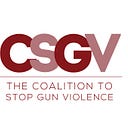Martin Luther King, Jr.’s Legacy Guides the Gun Violence Prevention Movement
Fifty years ago today, Dr. Martin Luther King, Jr., was shot and killed in Memphis, Tennessee. His death left millions of Americans grieving, but his enduring legacy as a champion of civil rights continues to this day. Dr. King’s organization of wide-scale civil rights movements across the nation was guided by his philosophy of nonviolent demonstration as a means of dismantling oppressive power structures. Today, these tenets can be used to guide the path towards resistance and change in the gun violence prevention (GVP) movement.
Throughout his lifelong struggle to fight for the equality of black Americans, Dr. King embraced a specific philosophy of nonviolent resistance: organizing large-scale, peaceful demonstrations against violence and inequality. His work drew on Mahatma Gandhi’s work in colonial India, which eventually forced British withdrawal in the face of millions-strong demonstrations that were impossible to ignore. Similarly, Dr. King was able to spearhead the push for racial justice in the 1960s by forcing it into the public eye. The Montgomery Bus Boycott in Alabama drew thousands and garnered nationwide media coverage. Later, the 1963 March on Washington, during which Dr. King gave his famous “I Have a Dream” speech, drew hundreds of thousands of protesters, black and white, to the nation’s capital.
In the half-century since Dr. King’s death, nonviolent political protests have been instrumental in creating societal change across the world. From student protests against the war in Vietnam to civil resistance against dictatorships in the Middle East, nonviolent movements have highlighted atrocities and made them impossible for the world to ignore.
Research has shown that one of the major strengths of nonviolent movements is their ability to build massive support. This was true in the 1950s when millions of black Americans were inspired by Dr. King’s work and walked out of their schools, sat at segregated lunch counters, and rode through Alabama. Eventually, their resilience, strength, and refusal to resort to violence in the face of unspeakably brutal retaliation led to landmark civil rights victories in the form of the Civil Rights Act of 1964 and the Voting Rights Act of 1965.
Similarly, the unrelenting wave of visible opposition to the National Rifle Association (NRA) and congressional inaction on gun violence in the aftermath of the Parkland, Florida shooting has commanded the attention of the nation and the world. On March 14, thousands of students walked out of their schools to honor the lives lost in Parkland just one month prior. Just 10 days later, on March 24, hundreds of thousands rallied in DC and their local communities to demand gun reform. These events featured not only the heartwrenching personal accounts of Parkland survivors, but also a diverse array of students who spoke about the impact of gun violence in communities whose names rarely make headlines.
Dr. King spent his life fighting for the rights of black Americans; the GVP movement cannot embrace his legacy without doing so as well. GVP has always been an intersectional issue, even if it has not always been presented as one. Communities of color are disproportionately impacted by gun violence. People of color who die as a result of gun violence are less likely to have their deaths covered by the media. The March for Our Lives rally was a meaningful sign that this tide may be shifting. Indeed, in the weeks since the march, the media has devoted significantly more attention to the often underrepresented impact of gun violence on people of color, from instances of police brutality to daily gun violence in impacted communities.
These widely visible displays of collective, nonviolent resistance are already making an impact. Hundreds of thousands have made their voices heard for the first time. Legislators are being forced to answer for their records on gun reform. Former NRA allies are distancing themselves from the organization. More state legislatures have been pressured to introduce meaningful GVP bills. Change is happening.
At the March for Our Lives, one of the youngest and most energetic speakers was Dr. King’s granddaughter, nine-year-old Yolanda King. Yolanda reminded the world of her grandfather’s dream that his grandchildren would not be judged by the color of their skin, but by the content of their character. She also shared her own dream: that “enough is enough.”
The people are working to make Yolanda’s dream become reality. We are witnessing progress, but we are not finished yet. Today and every day, we must remember Dr. King’s legacy. The most powerful way Americans can collectively advocate for an end to the epidemic of gun violence — in all its forms, across all our communities — is by embracing the legacy of nonviolent activism championed by Dr. King to his very last day. Enough is enough.
Mia AAssar is an intern at the Coalition to Stop Gun Violence. She is an undergraduate student at George Mason University double-majoring in history and conflict analysis and resolution. She is originally from Charlotte, North Carolina.
